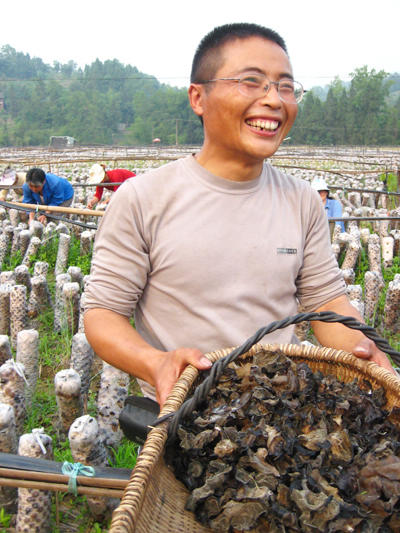|
 |
|
GETTING RICH: Farmer Huang Mingcong harvests black fungus in his field in Xuanhan County, Sichuan Province, on May 21, 2011 (DENG LIANGKUI) |
"A small foreign company may spend more than 20 million yuan ($3.1 million) a year on rape seed research, more than China's total annual spending in this field," said Fu Tingdong, a professor at Huazhong Agricultural University. He also blames the structure and allocation of research funding in China for being inflexible.
Zhang Zhenghe, a professor at the School of Economics and Management of China Agricultural University, said that in recent years, the government had increased financial supports to promote agricultural research and development, yet financial institutions failed to play their expected role.
"Many financial institutions are reluctant to support research and development programs because such investment is considered risky and has a long payback period. They would rather lend to companies with mature markets and products," Zhang said.
"The government is going to steadily increase the amount it invests in agricultural science and technology," said Zhang Taolin, Vice Minister of Agriculture, in November 2011.
In the same month, eight central government departments issued a circular on boosting financial investment in science and technology.
The document encourages financial institutions to support key agricultural research and development programs with more loans and help hi-tech companies raise funds in the capital market.
China has more than 100 public-listed agricultural companies, 60-70 percent of which have research and development programs projects.
"Universities and research institutes usually focus on basic scientific researches, whereas companies can engage in applied science innovation," said Song Jiening, an agricultural consultant in CIConsulting, a leading industry research institution in China.
"When I am 90 years old, the yield per hectare of hybrid rice should reach 15 tons, so that the land can feed 400 million more people," said 81-year-old Yuan Longping, an academician of the Chinese Academy of Engineering.
Yuan, who has dedicated his life to breeding more productive strains of rice, is known as "the father of hybrid rice." He believes that good seeds are the key to high rice output. So far 330,000 hectares of paddy fields in China have been planted with the Y Two Superior No.1 strain of rice developed by Yuan in 2001.
In September 2011, the Y Two Superior No.2 strain of rice Yuan was testing registered a record yield of 13.90 tons per hectare, whereas the yield per hectare of regular strains of rice was usually between 4.5 and 6 tons. The achievement firmly put China at the forefront of international research into hybrid rice.
Rice of this high-yielding strain is characterized by a large ear with many grains and strong resistance to diseases. In 2008, its patent was auctioned to a Chinese company at the price of 6.5 million yuan ($1 million).
Although China is good at producing hybrid rice, the country does not produce the best varieties and seeds of other crops. Data from the Ministry of Agriculture show that in China, more than 90 percent of the high-end vegetable and flower seeds used domestically are imported. In addition, 50 percent of the prime stud animals used in the rearing of pigs, chickens and cows are also imported.
In recent years, foreign breeding and seed companies have entered the Chinese market, seizing market share and crowding out some domestic companies in the industry.
| 